Related Research Articles
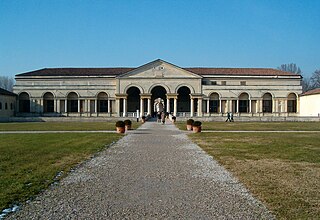
Palazzo del Te or Palazzo Te is a palace in the suburbs of Mantua, Italy. It is a fine example of the mannerist style of architecture, and the acknowledged masterpiece of Giulio Romano. Although formed in Italian, the usual name in English of Palazzo del Te is not that now used by Italians. The official modern name, and by far the most common name in Italian, is Palazzo Te. The English name arises because Vasari calls it the "Palazzo Del T", and English-speaking writers, especially art historians, still most often call it "Palazzo del Te".

Palazzo Strozzi is a palace in Florence, Italy.

The Palazzo Medici, also called the Palazzo Medici Riccardi after the later family that acquired and expanded it, is a Renaissance palace located in Florence, Italy. It is the seat of the Metropolitan City of Florence and a museum.
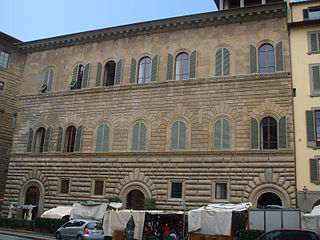
Palazzo Gondi is a palace in Florence, Italy, located a block from Piazza della Signoria. It was built in 1490 under design by Giuliano da Sangallo, who was inspired by other major works of stately buildings in the city, such as Palazzo Medici and Palazzo Strozzi. Among the elements borrowed from these earlier works are the cube-shape set around a central courtyard, the ashlar sloping on each of three floors, and the arched windows.
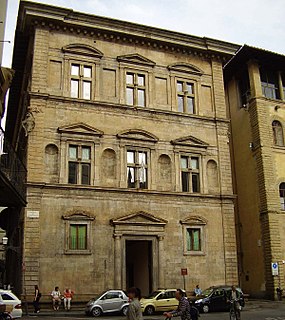
The Palazzo Bartolini Salimbeni is a High Renaissance-style palace located on Via de Tornabuoni on Piazza Trinita in central Florence, Tuscany, Italy.

Palazzo Antinori is a Renaissance palace located at the north end of Via de' Tornabuoni, where it makes an odd corner with Via dei Pecori, Via del Trebbio, and converts into Via dei Rondinelli, in Florence, region of Tuscany, Italy.

The Palazzo del Capitano del Popolo or Palazzo di Cante Gabrielli is a medieval palace in Gubbio, Italy. It is located in the San Martino's quartiere, near Porta Metauro, at the corner of via Gabrielli and via Capitano del Popolo.
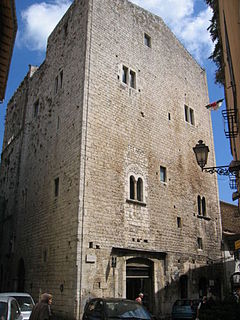
The Gottifredo Palace is a large medieval house in Alatri in the Lazio Region of Italy. It lies at the confluence of the main streets of Alatri at the time of the palace's construction: the first, coming from the north city gate of San Pietro; the second, from west, arrives from the ancient Via San Francesco which passes through the gate of the same name; the third from gate St Nicholas, to the east.

The Museo Nazionale di Palazzo Mansi is one of the two main art museum hosting tapestry collections and mainly post-19th century art collections owned by the city of Lucca, Italy. The collection is displayed in the Baroque palace, formerly belonging to the Mansi family, and located in central Lucca. Many of the original room decorations remain in place.

The Palazzo Bentivoglio is a late-Renaissance palace located on Via Garibaldi in central Ferrara, Region of Emilia-Romagna, Italy
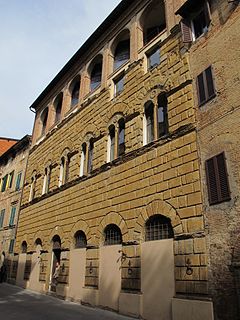
The Palazzo San Galgano is a Renaissance style urban palace located on via Roma number 47, in Terzo Camollia of the city of Siena, region of Tuscany, Italy. The palace is around the corner from the church of San Raimondo.

Palazzo Sansedoni is a Gothic style urban palace and tower, whose concave facade is situated facing the Palazzo Pubblico across the Piazza del Campo in the political center of the city of Siena, region of Tuscany, Italy.
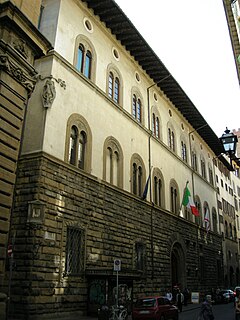
The Palazzo Pazzi, also known as the Palazzo della Congiura or Palazzo Pazzi-Quaratesi is a Renaissance-style palace and is located on Via del Proconsolo 10 at the corner with Borgo Albizzi in Florence, region of Tuscany, Italy. The palace is between the Palazzo Nonfinito and the Palazzo Pazzi-Ammannati to the north.
The Palazzo Capponi is a Baroque palace located on Via Gino Capponi #26 in Florence, region of Tuscany, Italy. There are apparently three other palaces once associated with the Capponi family:
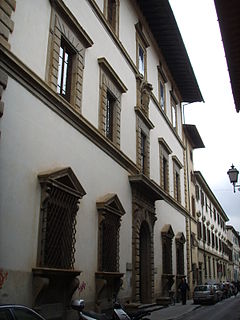
The Palazzo Giugni, also called the Palazzo Firenzuola, is a late-Renaissance or Mannerist architecture palace designed by Bartolomeo Ammanati, and located on Via degli Alfani #48 in the quartiere San Giovanni of Florence, region of Tuscany, Italy. It is located down the street from the Brunelleschi's church of Santa Maria degli Angeli.

San Benedetto in Gottella is a Romanesque-style, Roman Catholic church located on piazza Bernardin in Lucca, region of Tuscany, Italy. The church is located on Piazza Bernardini, near the Palazzo Bernardini, on the route of the ancient decumanus maximus of Lucca.
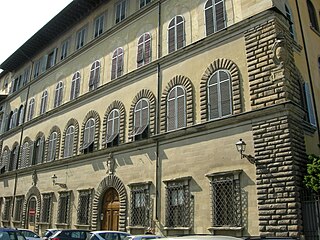
The Palazzo Torrigiani Del Nero is a Renaissance-style palace located at Piazza de' Mozzi 5, down the street where the Ponte alle Grazie enters the Oltrarno in Florence, Tuscany, Italy. Another Palazzo Torrigiani stands alongside, the smaller Palazzo Nasi. Both palaces also once belonged to the Nasi.

The Palazzo Contarini delle Figure is a Renaissance-style palace located between the Palazzo Mocenigo Ca' Vecchia and Palazzo Erizzo Nani Mocenigo, across the Grand Canal from the Palazzo Civran Grimani in the sestiere di San Marco in the city of Venice, Italy.

The Villa Marchese del Grillo, also known as the "100 Windows Villa," is a four-story palace located about 5 kilometres (3.1 mi) east of Fabriano in the Province of Ancona, Marche, Italy. Built in 1771 by the Marchese Onofrio del Grillo, the villa is considered to be an iconic landmark in Italy because of its history.

The Palazzo degli Anziani also known as the Palazzo del Comune, della Comunitá or del Giano is a Gothic-style stone palace located in the ancient historic center of Pistoia, Tuscany, Italy. The palace served as city hall for centuries; it still belongs to the comune and now mainly houses the Museo Civico d'Arte Antica.
References
- ↑ Guida di Lucca e dei luoghi più importanti del Ducato by marchese Antonio Mazzarosa, 1843, page 130.
- ↑ http://www.luccamuraurbane.it/pietra_del_diavolo_palazzo_bernardini.php Lucca Mura Urbane]], website of the Walls of Lucca.
Coordinates: 43°50′33″N10°30′20″E / 43.842579°N 10.505628°E